AMD’s 5 GHz Turbo CPU in Retail: The FX-9590 and ASRock 990FX Extreme9 Review
by Ian Cutress on August 9, 2014 8:00 AM ESTCPU Benchmarks: Comparing the AMD FX-9590
The dynamics of CPU Turbo modes, both Intel and AMD, can cause concern during environments with a variable threaded workload. There is also an added issue of the motherboard remaining consistent, depending on how the motherboard manufacturer wants to add in their own boosting technologies over the ones that Intel would prefer they used. In order to remain consistent, we implement an OS-level unique high performance mode on all the CPUs we test which should override any motherboard manufacturer performance mode.
It is worth noting that the FX-9590, against the A10-7850K for example, has double the threads and +1 GHz of core speed, despite the generational gap. Considering only these factors, the FX-9590 is most likely similar if not better at single threaded performance, but also 2x for multithreaded results.
HandBrake v0.9.9: link
For HandBrake, we take two videos (a 2h20 640x266 DVD rip and a 10min double UHD 3840x4320 animation short) and convert them to x264 format in an MP4 container. Results are given in terms of the frames per second processed, and HandBrake uses as many threads as possible.
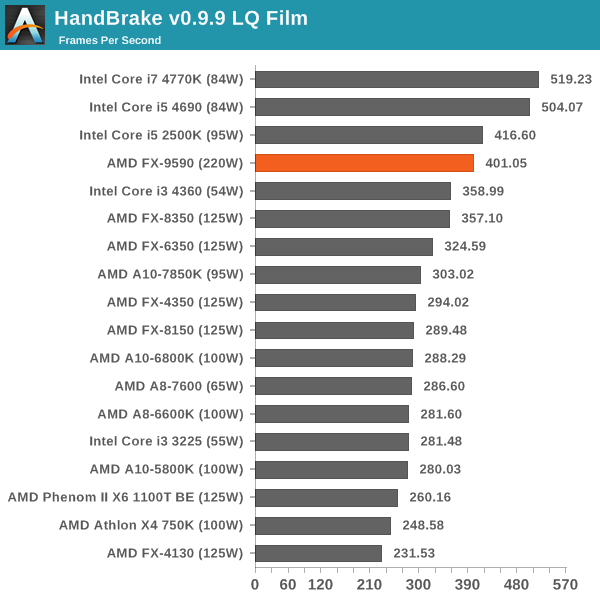
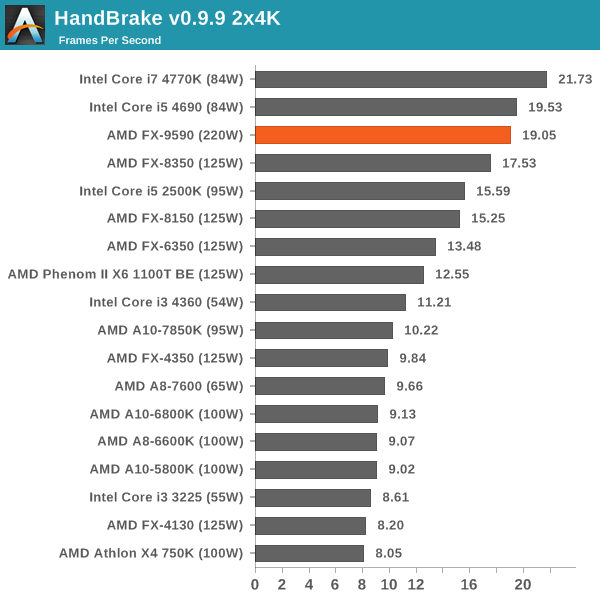
The eight threads of the FX-9590 give it almost another third of performance over the A10-7850K for small frame videos and nearly 2x for the larger frame conversion.
Agisoft Photoscan – 2D to 3D Image Manipulation: link
Agisoft Photoscan creates 3D models from 2D images, a process which is very computationally expensive. The algorithm is split into four distinct phases, and different phases of the model reconstruction require either fast memory, fast IPC, more cores, or even OpenCL compute devices to hand. Agisoft supplied us with a special version of the software to script the process, where we take 50 images of a stately home and convert it into a medium quality model. This benchmark typically takes around 15-20 minutes on a high end PC on the CPU alone, with GPUs reducing the time.
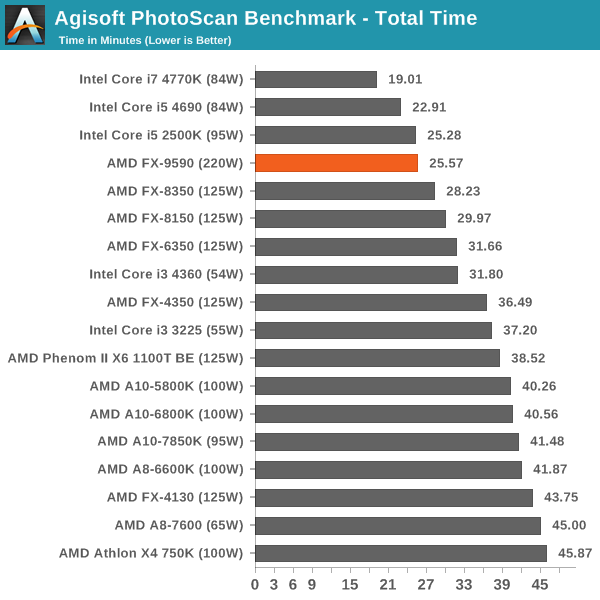
The FX-9590 puts in the best AMD CPU performance, similar to that of the i5-2500K.
Dolphin Benchmark: link
Many emulators are often bound by single thread CPU performance, and general reports tended to suggest that Haswell provided a significant boost to emulator performance. This benchmark runs a Wii program that raytraces a complex 3D scene inside the Dolphin Wii emulator. Performance on this benchmark is a good proxy of the speed of Dolphin CPU emulation, which is an intensive single core task using most aspects of a CPU. Results are given in minutes, where the Wii itself scores 17.53 minutes.
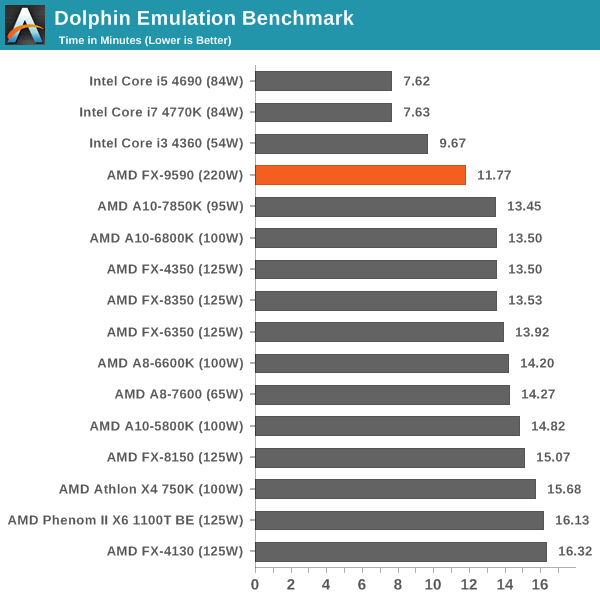
The FX-9590 beats almost everything pre-Haswell, showing the strength of a 5.0 GHz turbo mode. Note that it compares to the 3.5 GHz, 4MB L3 cache Haswell, which is 1.5 GHz slower and has half the L3.
WinRAR 5.0.1: link
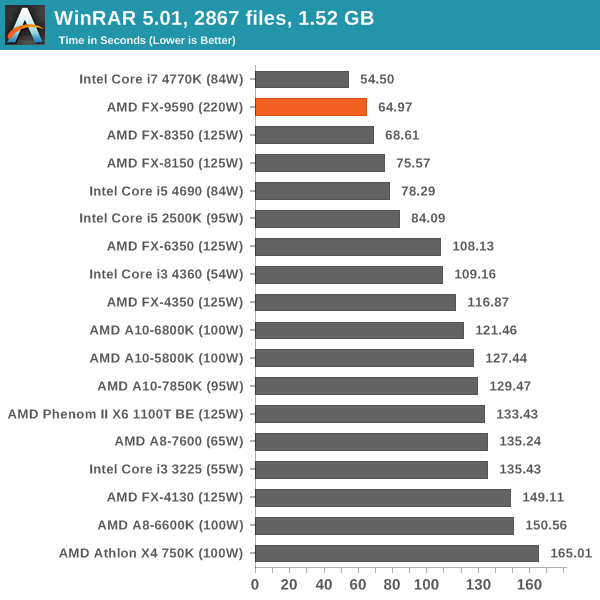
PCMark8 v2 OpenCL on R7 240
A new addition to our CPU testing suite is PCMark8 v2, where we test the Work 2.0 and Creative 3.0 suites in OpenCL mode.
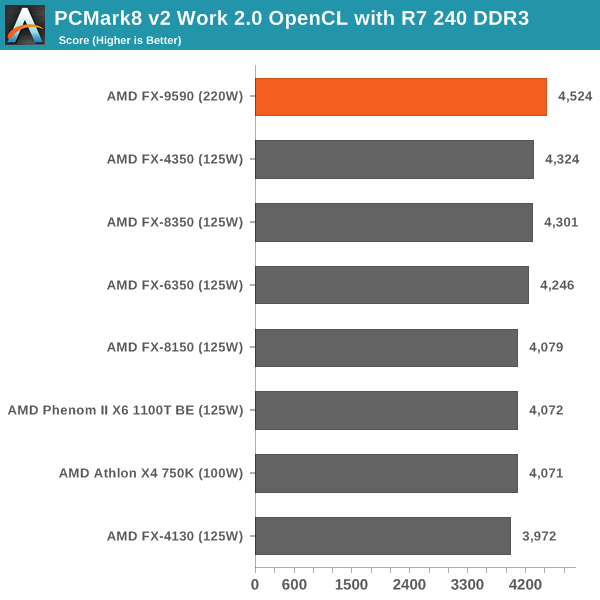
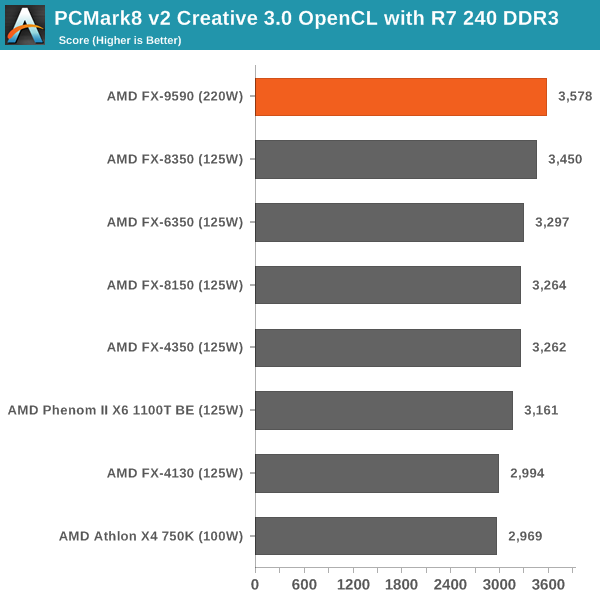
Hybrid x265
Hybrid is a new benchmark, where we take a 4K 1500 frame video and convert it into an x265 format without audio. Results are given in frames per second.
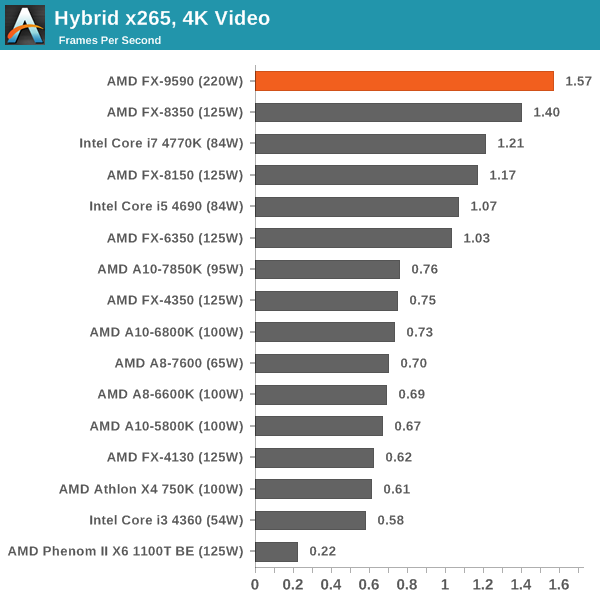
The FX-9590 holds up very well in the Hybrid x265 conversion, which makes me wonder how well an 8-thread Kaveri CPU would perform.
Cinebench R15
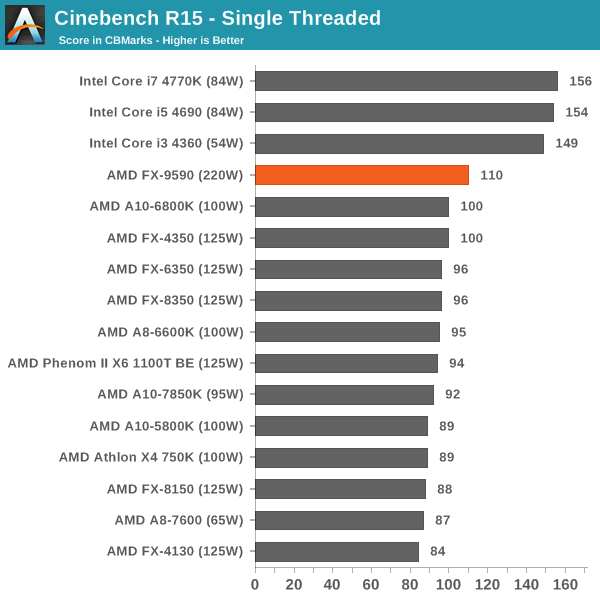
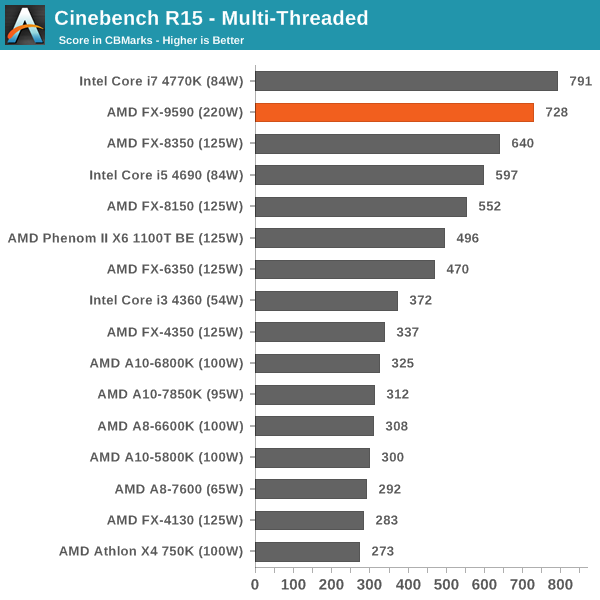
The FX-9590 still has the single thread edge over the newer AMD CPUs due to the high frequency, but is easily overtaken by the modern cheap Intel CPUs. For multithreaded competition, the 8 threads needs an 8 threaded Intel CPU to compete.
3D Particle Movement
3DPM is a self-penned benchmark, taking basic 3D movement algorithms used in Brownian Motion simulations and testing them for speed. High floating point performance, MHz and IPC wins in the single thread version, whereas the multithread version has to handle the threads and loves more cores.
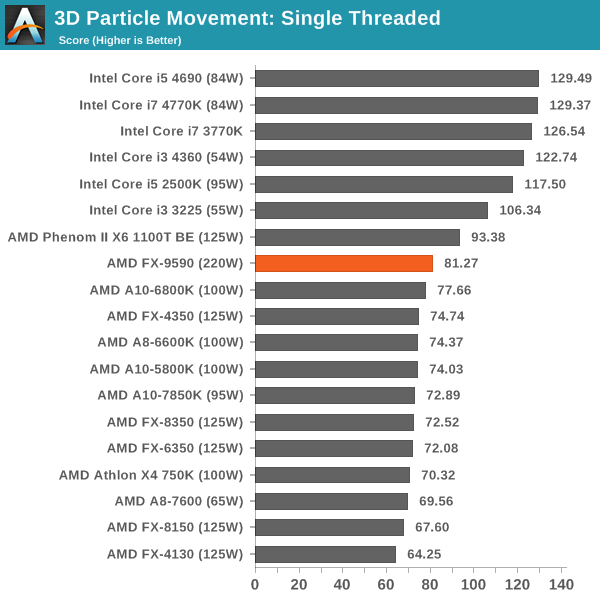
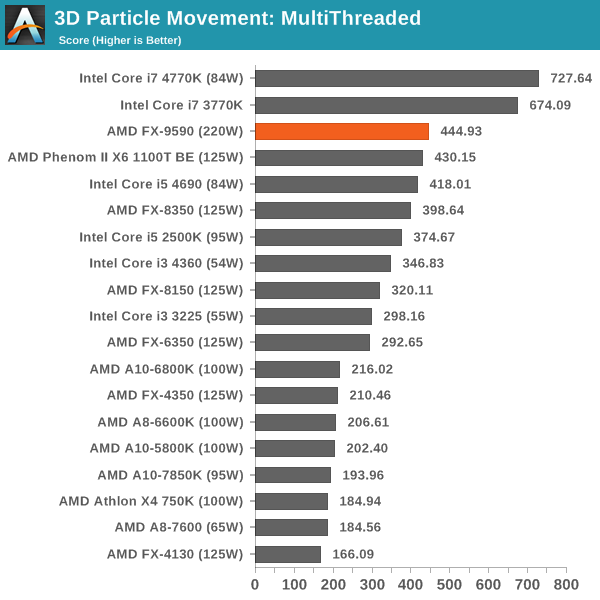
Although the FX-9590 again performs as the best AMD CPU, the floating point nature of the calculations in this test seems not to be favored by this architecture.
FastStone Image Viewer 4.9
FastStone is the program I use to perform quick or bulk actions on images, such as resizing, adjusting for color and cropping. In our test we take a series of 170 images in various sizes and formats and convert them all into 640x480 .gif files, maintaining the aspect ratio. FastStone does not use multithreading for this test, and results are given in seconds.

Similarly to 3DPM, for basic photo conversion any base 3.2 GHz Haswell CPU can outperform a 5.0 GHz AMD.










146 Comments
View All Comments
NeatOman - Saturday, August 9, 2014 - link
I have a FX-8320 @4.5Ghz, and never goes over 75c. I got it because it was $215 for both the CPU and a very good motherboard, and paired it with two HD 7850's. With that said, an overclocked i5@4.4Ghz is better then anything AMD can do over clocked even @5Ghz (for the most part) and at times far out classes it. But, an i5 and good motherboard will cost about $350 and $400+ for i7.. Almost twice. FYI, I live in Illinois and the electricity here is very very cheap.colinstu - Saturday, August 9, 2014 - link
a $300+ AMD chip?! LOL. Who the heck would buy this? It's not efficient, it's definitely not fast compared to $100 cheaper intel offerings (or similarly priced offerings in some of the other benches).swizeus - Saturday, August 9, 2014 - link
Second your opinion... It has been 3rd generation (or more ?) since FX gone out the door and AMD should have a solution to at least match Intel's performance by now, but why this ? It is pointless to have a power hungry beast that lost in the match with a processor that is halved in TDP in an Unzipping archive operation, not to mention electricity bill and the noise to cool down 220Watt TDP Processor... Not worth itRussianSensation - Sunday, August 10, 2014 - link
The amount of generations or the time span doesn't have any correlation with AMD catching up. Take an i7 4790K and manufacture it in 28-32nm node and see how awful it is. In other words, unless AMD can manufacture chips on the same node as Intel, it has no chance of competing whatsoever even if by magic their CPUs had identical IPC and clocks to Intel's. The delta in performance and performance/watt will only grow once Intel launches Skylake on 14nm next year.Budburnicus - Wednesday, March 11, 2015 - link
Umm a 4790K even at 32nm would still spank this chip across the board. How "awful" indeed...I mean forget the 4790K for a second, the 2600K at STOCK will beat this CPU out in nearly everything. and basically any i7-2600k on any board that supports overclocking WILL easily hit 4.2-4.4 - hell I had mine at 4.4 with a STOCK POS Intel Heatsink (POS in terms of its ability to cool, it is actually more than effective enough with how little heat the CPUs generate) - And at those speeds the 2600K beats out any and every AMD consumer CPU at almost everything, and what few benchmarks it will be behind in, it will not be by too much. And those benchmarks would include only VERY highly multithreaded applications of computational power - basically, server-type stuff. Certainly not in gaming!
Then there's the NEWER Intel CPUs like the i7-5930K (which I also own) which aren't too much more expensive than this flop, and will beat it out in absolutely anything and everything - at stock clocks again! With the exact same CoolerMaster Hyper 212 EVO I have on my i7-2600K machine (AWESOME cooler for the money, though I will probably replace the one currently on the 5930, as it does not provide the maximum OC headroom possible like it does on my 2600 machine) - with dual fans, I have all cores running totally stable at 4.4 GHz with 105.7 Bclock!
AMD really needs to dump this architecture for the consumer class entirely (though I admittedly am not too familiar with Server-class CPU benchmarks, from what I have read the newer Intel Xeon are spanking the current Opterons, but IIRC they still represent good value for money in the high end workstation and server classes - though Enthusiasts generally seem to stick with the Xeons as they like to be able to game at insane speeds and resolutions as well as do encoding, editing, CAD, etc. As I have seen quite a few "ULTIMATE Rig builds" where money is no issue, by people like NCIX, Linus Tech tips, PCper, and others on YouTube, but I have yet to see an ultimate Opteron machine)
So, yeah... All that speaks volumes to people who look at information objectively and without bias. IF AMD were to come out with a new chip tomorrow which not only spanked everything Intel has ever made, but also made it cheap like the original SandyBridge parts - and therefore changed the game, DAMNED right I would be coveting a brand new AMD rig, and would likely sell off my 2600K machine, despite my deep love for it (and the fact that it games slightly better than the 5930 due to higher core speeds by a decent bit) to try to fund such a build ASAP!
But as it is? You would have to be a blind fanboy to buy a CPU like this for a brand new build, as it does not perform well and eats power like crazy, requiring AMD to bundle a friggen AIO water-block with it! And even with the best of the best, it will BARELY overclock! So the stock speed benchmarks will never be too far from a sustainable, stable, overclock - a FAR different story from the i5-i7 2000-5000 K series CPUs - as I said, a pretty average overclock on an i7-2600K is 4.2 GHz, a full 1 GHz above stock speeds, as the 3.8 GHz turbo only works when a single core is under load, and even then it will still beat out tthis 5950 in most ways!
lurker22 - Saturday, August 9, 2014 - link
Is AMD even trying anymore? That power draw is PATHETIC in the year 2014xdrol - Saturday, August 9, 2014 - link
I think the fact that this very processor is still 'the' flagship shows that no, they are not even trying.TiGr1982 - Saturday, August 9, 2014 - link
No, they actually don't. This is just cherry-picked and overclocked FX-8350 from October 2012 with all the associated power draw and heat growing superlinearly because of the much higher operating voltage.However, AMD does develop their CPU side of the business, but since Kaveri this January the results go only into APUs (same will happen with Carrizo coming next year).
AMD APUs are actually very fine in their class, they are just in a shy situation regarding these factory overclocked 220W FXes. The rest of their lineup is fine.
StrangerGuy - Saturday, August 9, 2014 - link
300W alone for a CPU, holy mother of god. An entire Haswell gaming rig with 750 Ti would probably draw less power.BTW $250 is insane for any motherboard let alone an AMD one. That's an i5 4590 and a budget mobo right there already.
Daniel Egger - Saturday, August 9, 2014 - link
> 300W alone for a CPU, holy mother of god. An entire Haswell gaming rig with 750 Ti would probably draw less power.Don't know where you got that 300W from but yes, a decent Haswell system with 750 TI will not just probably but definitely draw less power than 300W. Mine takes around 35W idle and up to 120W in games.